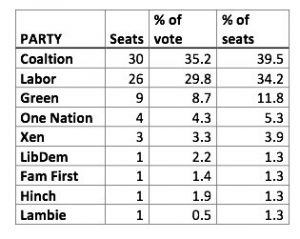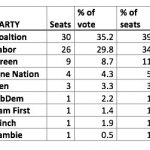
It is 262.784 cents for each first-preference vote. The unusual amount is due to indexation.
The main beneficiaries were: the Coalition $27.5m; Labor $23.2m; the Greens $6.7m; One Nation $1.8m and Xenophon $1.2m.
Now before you scream about political parties get this richly undeserved loot, this is in fact the good news – a story of fairness. The bad news is the story about other sources of money obtained by the political parties to fund the 2016 election. And the even worse news is that we do not know how much that was or where it came from, even though all the votes influenced by that money have been cast and counted.
Under Australian electoral law, disclosure of donations, by the donors who gave and the parties who received them, is not required until 24 weeks after the election – December 17.
Further, only donations over $13,000 have to be disclosed. There are no caps on donations federally. And there is nothing to stop someone giving just under the limit to each of the nine state, territory and federal branches of a party. Under present law, multiple donations under the donation limit can sometimes be given by different, but related, corporate and individual entities
Judging by the 2013 election, we can expect donations to far exceed public funding – probably by four or five times.
In 2013, the Coalition got $137 million in donations; Labor $78 million and the Greens $21 million.
Moreover, we do not know how much money was spent by which special-interest groups on general political messaging which supported the position of one side or the other.
We do know that given the closeness of the election, any one significant donor could reasonably say that most likely they influenced the outcome. That makes the political parties highly beholden to them.
This whole system needs a thorough overall. For a start, all donations over $1000 should be disclosed. They should be disclosed within 24 hours of being received and posted on the Australian Electoral Commission’s website for all to see. This is the age of instant information, after all.
Twenty-four weeks after the election is too late.
In 2013 we were told AFTER the election that the largest donor to the Liberals was private hospital operator Paul Ramsay Holdings, which, incidentally, gave nothing to Labor. Voters have a right to know BEFORE the election who is paying the piper.
The loophole whereby people can give to different state and territory branches of a party should be closed.
There should be caps on donations to parties of, say, $5000. Or at least a requirement to accept a cap or lose public funding.
Some control should be put on spending on political campaigns by third parties, such as industry groups. That will be tricky, but not impossible, in the face of the implied freedom of political communication in the Constitution.
In October last year all seven judges of the High Court upheld a NSW law capping donations to $2000 to individual candidates and $5000 to a party. And six of them upheld a ban on property developers making any donations at all.
After that case, NSW Liberal Premier Mike Baird said political donations should be put on the agenda at the Council of Australian Governments. But nothing came of it.
However, now, with a decidedly different Parliament, maybe the major parties could be pressured in action.
One of the problems in NSW was the ease with which developers could channel money through the Federal Liberal Party which had no caps on donations.
Obviously any cap on donations to individual candidates would also have to limit the number of candidates someone could give to, say, four or five. Otherwise someone could give $2000 to each of a political party’s 220 candidates, defeating the purpose of the cap.
We are fortunate to have such a wise High Court. In the US, their Supreme Court has struck down many attempts at controlling political donations and spending by “Public Action Committees” as being inconsistent with the First Amendment on freedom of speech.
It has led to the erosion of the democratic will.
Five of our judges, on the other hand, said about the implied freedom of political communication that the NSW provisions “support and enhance equality of access to government, and the system of representative government which the freedom protects”.
Justice Stephen Gageler said the provisions met the “compelling statutory object . . . of preventing corruption and undue influence in the government of the state”.
So Baird is right. The way is open to stop undue influence.
It may mean, of course, that we have to increase public funding. If so, it will be cheap at double the price, especially if it weeds out the rent-seekers, favour-seekers and purveyors of self-interest over the national interest.
0000000000000000000000
BY THE way, all of the talk about an aberrant Senate result is utter nonsense. The correlation between percentage of the vote and the percentage of the seats won is remarkably close, both state by state and even nationally.
The Coaliton, Labor and the Greens each got just three or four percent more seats than votes. The percentage of seats won by One Nation, Xenophon, the Liberal Democrats, Family First and Hinch was each less than 1.5 percent different from the percentage of their seats.
Lambie’s vote was fair for her state, even if nationally her “political party” was a bit over-represented.
Arguably, though, this has been the fairest result in Australia’s Senate history. It tells us that there would be nothing wrong with having a fixed four-year term for both the House of Representatives and the whole Senate.
CRISPIN HULL
This article first appeared in The Canberra Times and other Fairfax Media on 20 August 2016.
 DEMOCRACY and market capitalism hand in hand achieve much. But equally market capitalism can get out of hand. Money can influence votes and voters and the politicians they elect. We were reminded of this last Thursday when the Australian Electoral Commission announced the breakdown of $62.8 million in public funding to political parties, up from $58.1 million after the 2013 election.
DEMOCRACY and market capitalism hand in hand achieve much. But equally market capitalism can get out of hand. Money can influence votes and voters and the politicians they elect. We were reminded of this last Thursday when the Australian Electoral Commission announced the breakdown of $62.8 million in public funding to political parties, up from $58.1 million after the 2013 election.
I find your articles enjoyable and relevant even with having to allow for your constant left wing bias.
It is a shame after supplying the necessary facts that you couldn’t bring yourself to mention the role the Unions play in political funding. Along with highlighting Paul Ramsay Holdings, you could have also mentioned that the late Paul Ramsay bequeathed his entire shareholding in Ramsay Health ( in excess of 3 billion dollars) to his Foundation for the benefit of the public good. This is the biggest charitable be quite in Australian history.
I am not critical of your right to be left of centre. I just think your discourse and considerably researched facts would reach a higher standing that they deserve.
Regards,
Paul Thomas